*The Route 56 Challenge: Day 53*
Unfortunately, most of us don’t need to look far to see the destructive wake of cancer. As fitness professionals, the details of performance, and sometimes aesthetics even, all too often trump the focus of our daily work. At Functional Fitness on the Bluffs, fitness isn’t about getting a good workout in, it’s more about a lifestyle and growing within.
I’d like to welcome a guest piece written by David Haas, who is an advocate for the Mesothelioma Cancer Alliance. He is a follower of our community from afar and has recognized an opportunity to share the power of our training and it’s potential affects on cancer patients. Read on:
—
Fitness is an essential part of health maintenance, particularly for those suffering from serious health problems such as cancer. Exercise promotes immune health and reduces the side effects of chemotherapy and radiation therapy. It also bolsters mood and enhances patients’ quality of life, leading to greater immune function and stronger willpower to fight the illness.
Regular exercise increases levels of mood-supporting neurotransmitters in the brain, and researchers are continuing to find more links between mental and physical health. For example, in those currently experiencing stress and depression, illness strikes more frequently and wounds take longer to heal. Engaging in regular physical exercise makes a huge difference for patients in terms of mood and their ability to cope with the huge physical and emotional toll of cancer treatment. Another way exercise contributes to mood is by providing opportunities for group exercise, a source of valuable social interaction with the valuable side effect of improved immune health.
Exercise can be divided into two types: Aerobic exercise and anaerobic, each with their own benefits to mood and health. Aerobic forms of exercise such as running, cycling, or swimming increase oxygenation, which is known to assist the body in fighting immune threats. In cancers such as mesothelioma where the lungs are affected, aerobic exercise helps to retain healthy lung capacity. Anaerobic training such as strength training raises hormones levels such as testosterone. Improved hormonal functioning enhances mood and supports healthy bone density, which is worsened by cancer treatments such as chemotherapy.
Yoga is another type of exercise that is gaining in popularity as more people become aware of its numerous benefits to physical and emotional health. Practitioners say that yoga helps enhance the mind-body connection and reduces stress levels. A 2009 study of women with breast cancer found that yoga not only reduced anxiety and depression but also regulated cortisol levels, which was especially significant because higher daytime cortisol levels are associated with worse outcomes for breast cancer patients. Yoga also improves flexibility, which is valuable in patients who are forced to spend time resting indoors, unable to engage in more rigorous exercise. In addition, yoga classes are another opportunity for cancer patients to raise their spirits and immunity by interacting with others in a positive atmosphere. —David Haas
—
If this message is relevant for someone in your life, this may be an opportunity to share the message. Part of what David does is leveraging the experiences of those with cancer to fight it. The more we talk and share, the better fit we are to tackle the beast that is cancer.
Logan Gelbrich
———————–
Wednesday’s Workout:
In 5 minutes:
400m Run
20 Hand Release Push Ups
AMRAP Deadlifts (155/115)
-Rest 5 minutes-
In 5 minutes:
400m Run
15 Deadlifts
AMRAP Hand Release Push Ups
—————————————————————————————————————————————————————————————-
[googleapps domain=”docs” dir=”spreadsheet/embeddedform” query=”formkey=dHE1MmlZMXJ4UWdwa1pYdW00aTVOZlE6MQ” width=”760″ height=”1073″ /]





1 Comment
Cool workout!